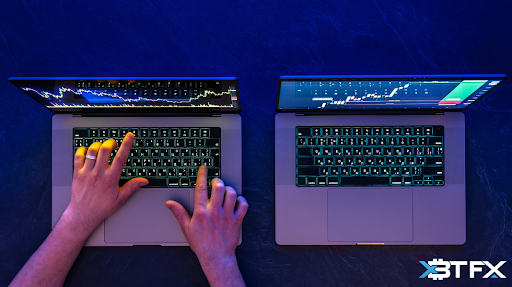A new type of investor is emerging as financial markets change at a rate never seen before; they are tech-savvy, time-conscious, and more dependent on intelligent platforms. Copy trading, a ground-breaking tactic that automates the investing process by mimicking the trades of seasoned professionals, is at the center of this evolution.
Copy trading is no longer a specialized choice in 2025. Millions of people worldwide use this common investment strategy to increase their market exposure without needing in-depth technical knowledge. This model is changing how people invest and democratizing access to institutional-grade strategies, regardless of your focus on stocks, forex, or cryptocurrency.
What Is Copy Trading?
A type of portfolio management called copy trading enables people to replicate in real time the trading moves of experienced or professional traders. Users allocate capital that automatically replicates the trades of one or more traders they choose to follow through specialized platforms.
Copy trading allows for passive participation based on a well-informed choice of strategy providers, in contrast to traditional investment methods that necessitate in-depth market research, chart analysis, and active monitoring. It provides the accuracy of technology and the wisdom of seasoned investors, bridging the gap between algorithmic automation and human expertise.
How Copy Trading Works: A Step-by-Step Overview
- Platform Selection
Choosing a trustworthy copy trading platform is the first step for investors. Prominent platforms like XBTFX, ZuluTrade, eToro, and NAGA provide access to a variety of asset classes, including stocks, forex, indices, and cryptocurrencies, along with transparency and comprehensive analytics.
Key selection criteria include:
- Regulatory oversight
- Fee structure
- Range of supported assets
- Depth of trader performance metrics
- User interface and mobile accessibility
- Trader Evaluation
Once registered, users gain access to trader profiles complete with key indicators such as:
- Historical returns
- Win/loss ratios
- Risk scores
- Trading frequency
- Asset breakdowns
These indicators assist users in matching their decisions to their personal investment goals and risk tolerance.
- Capital Allocation
After that, investors give their selected traders capital. Although the investor still has control over the funds, they are automatically deployed to replicate trades proportionately. Depending on the platform, minimum investment thresholds typically fall between $100 and $500. - Automated Execution
The investor’s account is updated in real-time whenever a trader executes a position, whether it be an opening or closing trade. The investor’s capital in relation to the trader’s total fund size determines the size of the position. - Ongoing Portfolio Monitoring
Even though copy trading is mostly automated, it still needs to be reviewed on a regular basis. Investors can change traders, halt copying, or adjust allocations in response to shifting market conditions or performance indicators. For added risk management, the majority of platforms also provide drawdown limits and stop-loss settings.
Why Copy Trading Is Redefining Investment in 2025
1. Accessibility Without Expertise
By granting access to sophisticated trading strategies without necessitating in-depth financial knowledge, copy trading empowers both novices and time-pressed professionals. Without spending hours on technical analysis or research, investors can trade in international markets.
2. Integration of Human Intelligence and Automation
In contrast to completely automated robo-advisors, copy trading uses the knowledge of human traders—those who depend on technical signals, macroeconomic data, and strategic timing—while automating quick and accurate execution.
3. Democratization of Institutional-Level Strategies
In the past, hedge funds and private wealth managers were the only ones with access to elite trading insights. By 2025, individual investors can now transparently replicate these strategies by examining risk metrics and historical data prior to committing. This is made possible by platforms such as XBTFX.
4. AI-Enhanced Personalization
Machine learning algorithms that examine user behavior, risk tolerance, and market trends to recommend the best trader matches power contemporary copy trading systems. By proactively identifying irregular trading patterns and suggesting portfolio modifications, certain platforms improve the intelligence and responsiveness of the investing process.
5. Community-Driven Transparency
Investors of today look for transparency and shared learning in addition to numbers. With community reviews, leaderboards, public trader feeds, and educational resources aimed at promoting sustained engagement and trust, platforms are developing into social investment ecosystems.
Copy Trading in Volatile Markets
Many investors find it difficult to manage volatility as macroeconomic uncertainty, geopolitical risks, and inflation continue to influence financial markets. By diversifying across several asset classes and following experts with established risk management frameworks, copy trading offers a strategic buffer.
Some platforms offer additional protective features:
- Dynamic drawdown protection
- Real-time capital reallocation
- Instant trader switching
- Risk score-based auto-adjustment
Best Practices for Successful Copy Trading
To make the most of copy trading, a structured approach is essential:
- Avoid chasing past performance: Without knowing the strategy and volatility underlying it, a high return on investment can be deceptive.
- Diversify across multiple traders: To reduce individual trader risk, distribute money among several trading philosophies (such as cryptocurrency, forex, and stocks).
- Start small, scale with consistency: Start with the least amount of money and only raise it after consistent performance.
- Utilize platform risk tools: Your portfolio can be protected by capital allocation caps, maximum drawdowns, and stop-loss limits.
- Monitor regularly without overreacting: Short-term swings are common; evaluate performance every month and rebalance on occasion.
- Stay informed: Even though you’re not trading by hand, performance can be better understood by having a basic understanding of market sentiment and macroeconomic trends.
Final Thoughts: The Investment Model of the Future
Copy trading is one of the most significant changes in personal finance in an era dominated by data, automation, and transparency. It gives investors a more intelligent, approachable means of accumulating wealth by fusing the scalability of digital platforms with the knowledge of seasoned professionals.
Copy trading offers an introduction to complex, performance-based investing without the typical learning curve, regardless of whether you’re a professional with limited time or a retail trader making your first foray into the market.
Copy trading is becoming more than just a fad; it is the new norm for astute investing as financial markets continue to change in 2025 and beyond.









































